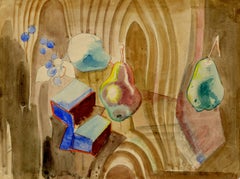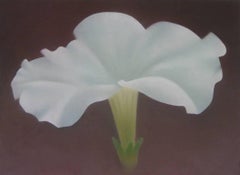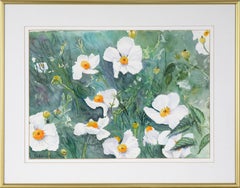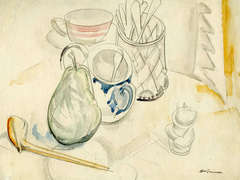William Sommer Still-life Drawings and Watercolors
American, 1867-1949
William Sommer is seen as a key person in bringing European modernism to Northeast Ohio. He was born in Detroit, Michigan, and in his youth apprenticed for seven years to a lithographer.
He briefly studied at an art academy in Germany and then worked as a lithographer in New York before moving to Cleveland, where he was awarded a major contract with the Otis Lithography Company. There he became friends with sculptor and painter William Zorach, and the two, determined to be fine artists, began painting together on weekends. They also became intrigued by avant-garde movements, especially after Zorach's trip to Paris in 1910.
In 1911, Sommer co-founded a group in Cleveland called the Kokoon Club, a mixed group of commercial artists and radical modernists who sought the freedom to pursue their independent tendencies. They converted a tailor's shop into a studio and held exhibitions and lectures and organized an annual masked ball that became the focus of Cleveland's bohemian life.
In 1913, he and his colleagues began painting at Brandywine, about 30 miles south of Cleveland and made a school house into a studio. They devoted increasing time to watercolor painting because they could work spontaneously and it would dry quickly. Rejecting the conventional ideas of beauty, they strove for the expression of emotion and spontaneity and fantasy. One of Sommer's most successful students was Charles Burchfield.
As he was perfecting his mature style, he had financial difficulties because he made his living from commercial lithography, which was becoming obsolete, and the Depression was hitting the nation causing him to lose his job. He became a WPA artist, doing murals in northeastern Ohio.
After his death at age 82, he was largely forgotten until 1980 when Hilton Kramer, a "New York Times" critic, praised his work. In May to July, 1994, the Ohio Arts Council held a retrospective of his work at the Riffe Gallery in Columbus. His work is found in many public collections including the National Museum of American Art, The Metropolitan Museum of Art, and the Whitney Museum of American Art.to
1
1
Overall Width
to
Overall Height
to
2
1
1
2
1
1
1
1
13
87
69
41
30
2
Artist: William Sommer
untitled (Still Life with Apples and Vase of Flowers)
By William Sommer
Located in Fairlawn, OH
[recto];untitled (Sketches for Still
Unsigned
9 1/2 x 12 inches (24.2 x 30.6 cm.)
Category
20th Century William Sommer Still-life Drawings and Watercolors
Materials
Graphite
Still Life with Tromp L'Oeil
By William Sommer
Located in Fairlawn, OH
Still Life with Tromp L'Oeil
Graphite and watercolor on a book page.
Signed in ink by the artist lower right corner
(see photo)
Provenance:
Estate of the artist (Estate No. 00916 verso)
Ray Sommer (the artist's son)
Joseph M. Erdelac (No. 18 JME verso)
Book page verso is an illustration of a Durer woodcut...
Category
1920s American Modern William Sommer Still-life Drawings and Watercolors
Materials
Watercolor
Related Items
Flower
By Robert Peterson
Located in Dallas, TX
Robert Peterson, "Flower," pastel on paper, 19 x 26 1/4 inches paper size, 27 1/4 x 35 inches including white mat and frame.
The artwork is floated in the mat and only hinged at the...
Category
20th Century American Modern William Sommer Still-life Drawings and Watercolors
Materials
Paper, Pastel
White Poppies - Botanical Watercolor on Paper
Located in Soquel, CA
White Poppies - Botanical Watercolor on Paper
Detailed floral watercolor by Harry Federico (American, 1922-2022). Several white poppies ...
Category
21st Century and Contemporary American Modern William Sommer Still-life Drawings and Watercolors
Materials
Watercolor, Laid Paper
$747 Sale Price
35% Off
H 21.25 in W 27.25 in D 1 in
A Stunning ca. 1950s Cubist Watercolor of Irises by Rita Duis (Astley-Bell)
Located in Chicago, IL
A stunning Cubist watercolor on paper of purple irises by Chicago and New York artist Rita Duis (Astley-Bell). Archivally matted to30" x 24".
Artist Rita Duis (Astley-Bell) led an ...
Category
1950s American Modern William Sommer Still-life Drawings and Watercolors
Materials
Watercolor, Paper
$575 Sale Price
52% Off
H 30 in W 24 in
Ca. 1945 Cubist Graphite on Paper Still Life Drawing by Artist Stanley Bielecky
By Stanley Bielecky
Located in Chicago, IL
A ca. 1945, Cubist black & white graphite drawing of fruit by artist Illinois and Michigan artist Stanley Bielecky. Image size: 4" x 5". Archivally matted to: 13 1/4" x 16".
Stanley Bielecky was an Indiana artist who painted the American scene, from the factories and workers around East Chicago to the bucolic settings of Mackinac Island...
Category
1940s American Modern William Sommer Still-life Drawings and Watercolors
Materials
Graphite, Paper
$485 Sale Price
25% Off
H 13.25 in W 16 in
A ca. 1938 Graphite on Paper Study of Classical Drapery by Modernist Jan Matulka
By Jan Matulka
Located in Chicago, IL
A ca. 1938 graphite on paper, study of a classical drapery by notable Modernist artist Jan Matulka. The image is drawn on the back of a typewritten, folded sheet of stationery, from...
Category
1930s American Modern William Sommer Still-life Drawings and Watercolors
Materials
Paper, Graphite
$520 Sale Price
20% Off
H 16 in W 20 in
"Flower 1" Graphite Drawing
By Lindsay Payton
Located in Houston, TX
Black and white graphite drawing of a dropping flower. The artist signed the print and titled it. It is framed in a black frame with a white matte.
Dimensions without Frame: H 11 in ...
Category
21st Century and Contemporary Contemporary William Sommer Still-life Drawings and Watercolors
Materials
Graphite
Flower Bouquet
Located in Los Angeles, CA
(Note: This work is part of our exhibition Connected by Creativity: WPA Era Works from the Collection of Leata and Edward Beatty Rowan)
Watercolor on paper, 12 x 9 ½ inches unframed sheet, 15 x 12 ½ inches framed, signed lower left
About the Artist:
Nan Watson...
Category
1930s American Modern William Sommer Still-life Drawings and Watercolors
Materials
Watercolor
Garden Flowers
By Charles Demuth
Located in New York, NY
Charles Demuth was one of the most complex, talented, and deeply sensitive artists of the American modern period. Whether he was painting floral still lifes, industrial landscapes, or Turkish bathhouses, art was, for Demuth, fraught with personal meaning. A fixture of the vanguard art scene in New York, Demuth navigated the currents of Modernism, producing some of the most exquisite watercolors and original oil paintings in twentieth-century American art.
Demuth was born in Lancaster, Pennsylvania, the only child of a well-to-do family. He had an awkward and introverted childhood shaped by a childhood illness, Perthes, a disease of the hip that not only left him permanently lame, but, as part of the “cure,” bedridden for two years in the care of his mother. This long period of incapacitation had a deep impact on Demuth, who came to see himself as an invalid, an outsider who was different from everyone else. It was perhaps during this period of indoor confinement that his keen interest in art developed. Several relatives on his father’s side had been amateur artists, and, following his convalescence, his mother encouraged his artistic pursuits by sending him to a local painter for instruction. The majority of his early pictures are of flowers, a subject for which Demuth maintained a lifelong passion.
Following high school, Demuth enrolled at the Drexel Institute of Art in Philadelphia, a school renowned for its commercial arts program. He advanced through the program rapidly, and, in 1905, at the encouragement of his instructors, he began taking courses at the Pennsylvania Academy of the Fine Arts. The two leading teachers then at the Academy were William Merritt Chase and Thomas Anshutz. Anshutz, himself a former student of Thomas Eakins, was well liked by his students, and is best known as the teacher of Robert Henri, John Sloan, and several of the other artists of the Ashcan School. Demuth, too, adopted a similar idiom, working in a controlled, realistic manner while at the Academy, where he remained until 1910.
In 1907, Demuth made his first trip to Europe, staying in Paris. He spent time on the periphery of the art scene composed of the numerous American artists there, including John Marin and Edward Steichen. He returned to Philadelphia five months later, and immediately resumed courses at the Academy. Despite his introduction to advanced modern styles in Europe, Demuth’s work of this period retains the academic style he practiced before the trip. It wasn’t until he had summered at New Hope, Pennsylvania, in 1908 and 1911, that his style began to evolve. New Hope was a prominent American Impressionist art colony whose members were largely affiliated with the Pennsylvania Academy. Demuth dropped the conservative tone of his style and adopted a freer and more colorful palette.
Although he remained based in Philadelphia, Demuth frequently went to New York during this period. Many of the same American artists of the Parisian art scene Demuth had encountered on his earlier European trip now formed the nucleus of New York’s avant-garde, which centered around Alfred Stieglitz’s 291 gallery. It wasn’t long before Demuth began to apply modernist-inspired strategies to his work. He was particularly influenced by the watercolor work of John Marin, also a former student of Anshutz, whose bold use of color in the medium Demuth freely adapted into looser washes of color.
In 1912, Demuth again left for Paris, this time studying in the Académie Moderne, Académie Colorossi, and Académie Julian. In Paris Demuth met the American modernist Marsden Hartley. Hartley, a principal figure in the expatriate art circle, acted as a mentor to Demuth, and introduced him to the wide array of modern styles currently practiced in Europe. Hartley also introduced Demuth to many of the members of the Parisian avant-garde, including Gertrude Stein. Demuth was an aspiring writer, and he spent many hours in conversation with Stein. He wrote extensively during this period, and published two works shortly after his return to America. He also developed an interest in illustrating scenes from literary texts. From 1914 to 1919, Demuth produced a series of watercolors of scenes from books such as Emile Zola’s Nana and Henry James’s The Turn of the Screw.
Upon his return to America, Demuth settled in New York. In 1914, Demuth had his first one-man show at Charles Daniel’s gallery, which promoted emerging modern American artists, including Man Ray, Rockwell Kent, Yasuo Kuniyoshi, Stuart Davis, and Max Weber. Demuth drew closer to the artistic vanguard in New York, becoming friends with many in the Stieglitz and Daniel circles, including Georgia O’Keeffe, Marcel Duchamp, Carl Van Vechten, and Edward Fiske.
New York’s cosmopolitan atmosphere and active nightlife appealed greatly to Demuth. In a sketchy style well suited to watercolor, he painted many vaudeville and circus themes, as well as nightclub, café, and bathhouse scenes. Often with Duchamp, Demuth took part in an urban subculture replete with nightclubs, bars, drugs, and sexual permissiveness, which, for a homosexual artist like himself, allowed room for previously unattainable personal expression. Demuth’s pictures of sailors, bathhouses, and circus performers embody a sensual and sexual undercurrent, expressing the artist’s sense of comfort and belonging in the bohemian subculture of New York.
Simultaneously, Demuth deepened his interest in floral pictures, painting these almost exclusively in watercolor. His style evolved from the broad color washes of his earlier pictures to more spare, flattened, and sinuous compositions, inspired by the drawings of Aubrey Beardsley and other artists of the Aesthetic Movement. Demuth’s flower watercolors are moody and atmospheric, sensuous and elegant, introspective and yet full of expressive power. Moreover they are beautiful, and are unequivocally among the finest still lifes in American art. Despite numerous subsequent artistic undertakings that led him in a variety of directions, Demuth never stopped painting flower pictures, ultimately adding fruits and other still-life objects to his repertoire.
In 1916, Demuth began to develop a style later known as Precisionism, a form of landscape painting infused with Cubism, in which space is divided into precisely drawn geometric regions of color. Demuth first began to paint the landscape in an appropriated Cubist mode while on a trip with Hartley to Bermuda. In these early landscapes, in which the curvilinear forms of trees intersect the geometrically articulated architectural forms, Demuth explored ideas that shaped the future development of modernism in America.
The full realization of Demuth’s explorations came after his return to America in 1917, when he turned his attention to industrial subjects. These works derive from a “machine aesthetic,” espoused by New York artists such as Francis Picabia, Joseph Stella, Albert Gleizes, and Duchamp, by which artists viewed machines as embodying mystical, almost religious significance as symbols of the modern world. Rather than painting the skyscrapers and bridges of New York as did most of his like-minded contemporaries, Demuth returned to his home town of Lancaster, where he painted factories and warehouses in a Precisionist idiom. The titles for these pictures are often contain literary references, which serve as clues for the viewer to aid in the decoding of the artist’s meaning.
In 1923, Demuth planned a series of abstract “poster portraits” of his friends and contemporaries in the New York art and literary scene. In these “portraits,” Demuth combined text and symbolic elements to evoke the essential nature of his sitters’ distinguishing characteristics. In this fashion, he painted portraits of such artists as Georgia O’Keeffe, John Marin, and Arthur Dove. His most famous poster portrait, I Saw the Figure 5 in Gold...
Category
20th Century American Modern William Sommer Still-life Drawings and Watercolors
Materials
Paper, Watercolor
Untitled Still Life
By Nikos Kanarelis
Located in New York, NY
Untitled Still Life, 2014
Graphite on paper
17.4 x 20.85 / 44 x 53 cm
Nikos Kanarelis was born in Athens, Greece in 1975 where he now lives and works. Βetween 1999 and 2004 he s...
Category
21st Century and Contemporary Contemporary William Sommer Still-life Drawings and Watercolors
Materials
Archival Paper, Graphite
Cherry Blossoms 3, A Realist Black and White Drawing of Flowers on a Branch
By Mary Reilly
Located in New York, NY
This graphite drawing by Mary Reilly captures the delicate beauty of blossoms she encountered on a walk in Vermont. Reilly, known for her mastery of graphite pencil, transforms ordin...
Category
2010s Realist William Sommer Still-life Drawings and Watercolors
Materials
Paper, Pencil, Graphite
Seashells 5, photorealist black and white graphite drawing
By Mary Reilly
Located in New York, NY
Mary Reilly’s laborious method of toning her paper serves as the starting point for her intricate compositions. She begins by covering the entire sheet with up to eight smooth, unmod...
Category
2010s Photorealist William Sommer Still-life Drawings and Watercolors
Materials
Paper, Graphite
Field of Flowers 2, photorealist graphite floral drawing, 2016
By Mary Reilly
Located in New York, NY
Reilly uses a toning technique to endow her graphite works with a smooth, seamless quality. Rather than distinct outlines, her flower petals glide gracefully into the surrounding spa...
Category
2010s Contemporary William Sommer Still-life Drawings and Watercolors
Materials
Archival Paper, Pencil, Graphite
$1,440 Sale Price
20% Off
H 8 in W 6 in
Previously Available Items
Still Life (with pipe, apple, sugar bowl and cup and saucer)
By William Sommer
Located in Fairlawn, OH
Signed with estate stamp C
Provenance:
Joseph M. Erdelac, Cleveland, Inv. # M.J.M.E. 29
Category
1920s William Sommer Still-life Drawings and Watercolors
Materials
Graphite, Watercolor
William Sommer still-life drawings and watercolors for sale on 1stDibs.
Find a wide variety of authentic William Sommer still-life drawings and watercolors available for sale on 1stDibs. If you’re browsing the collection of still-life drawings and watercolors to introduce a pop of color in a neutral corner of your living room or bedroom, you can find work that includes elements of orange and other colors. You can also browse by medium to find art by William Sommer in graphite, paint, pencil and more. Not every interior allows for large William Sommer still-life drawings and watercolors, so small editions measuring 12 inches across are available. Customers who are interested in this artist might also find the work of Dick Wray, Lou Fink, and Ian Hornak. William Sommer still-life drawings and watercolors prices can differ depending upon medium, time period and other attributes. On 1stDibs, the price for these items starts at $550 and tops out at $3,000, while the average work can sell for $1,775.




